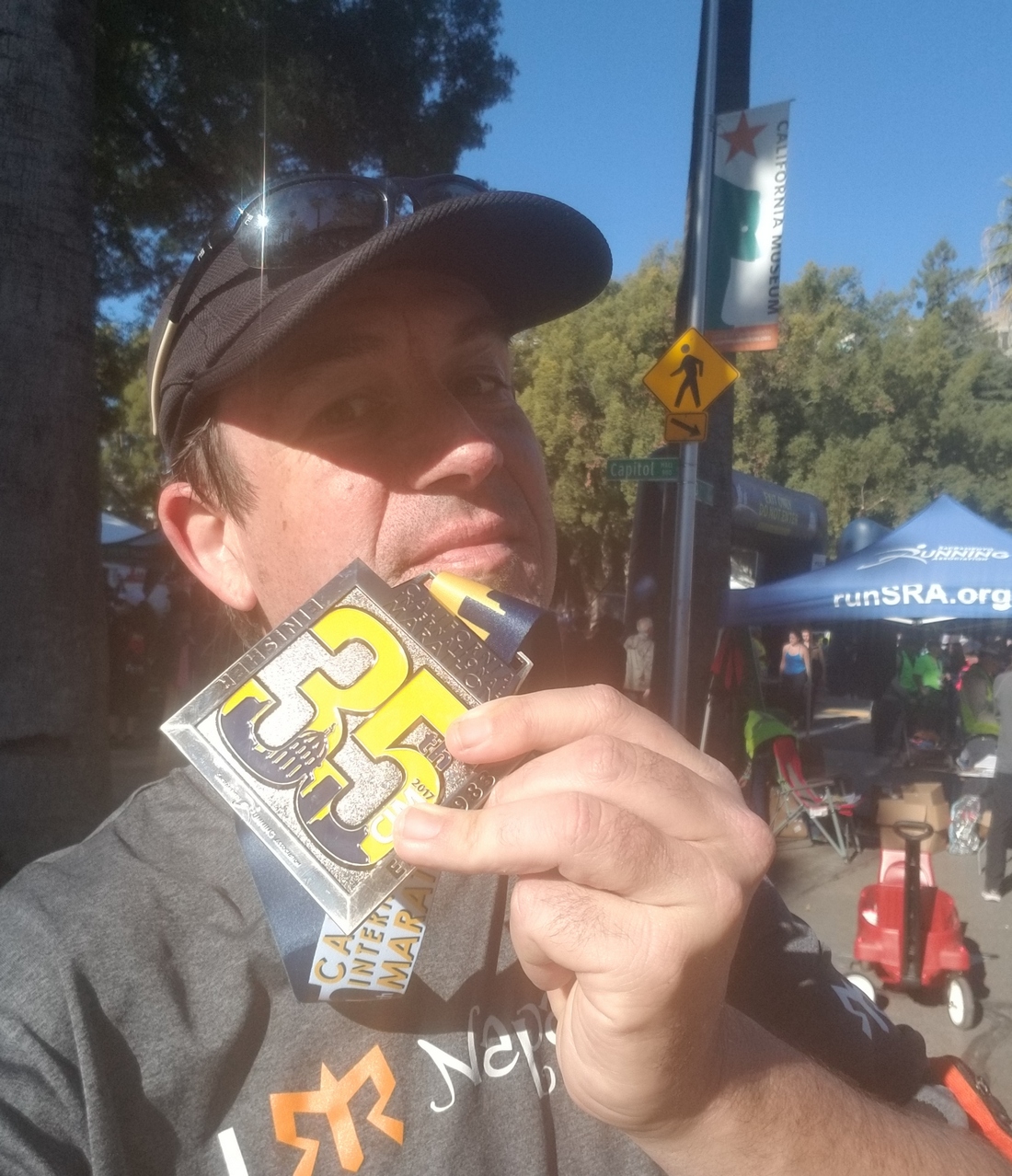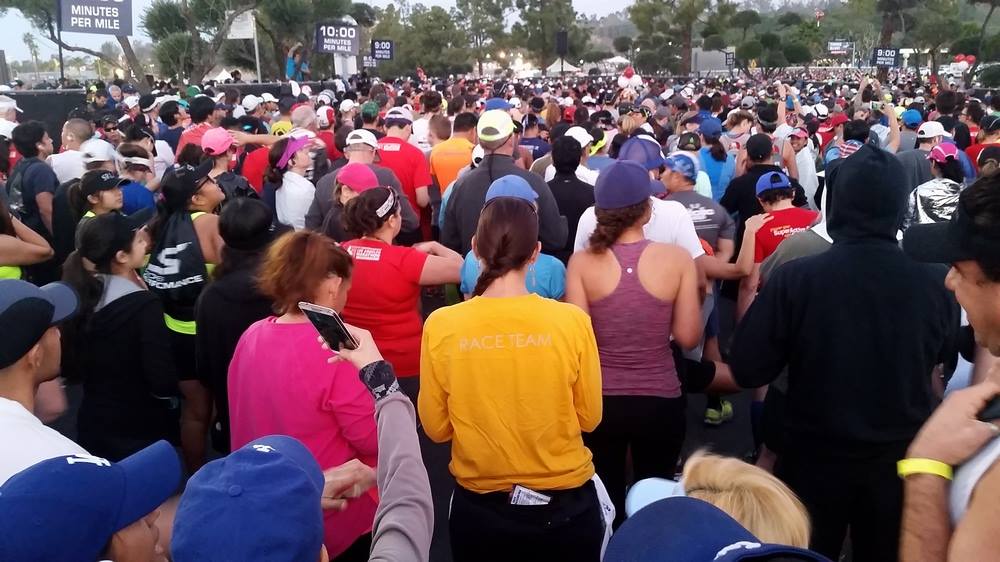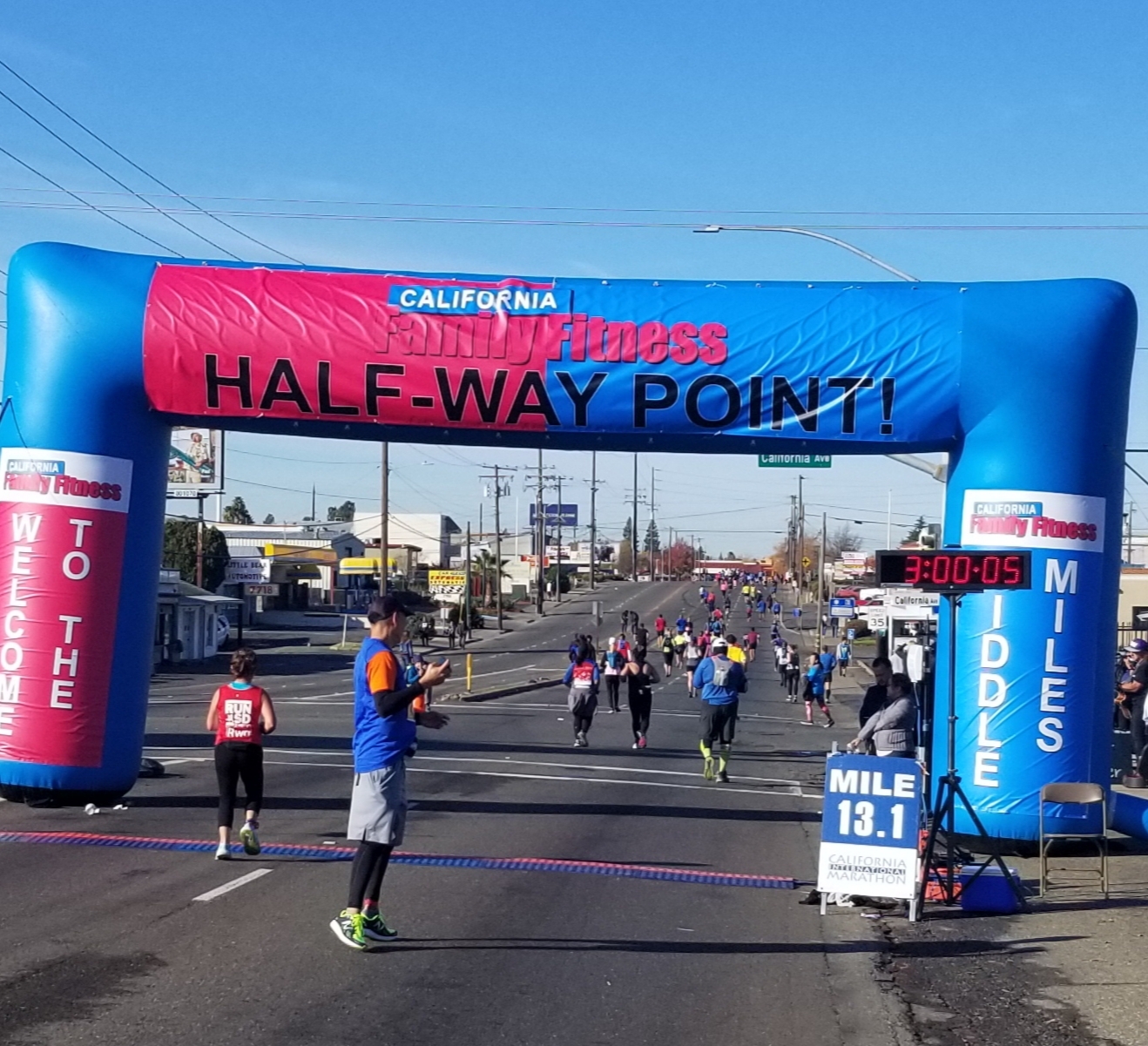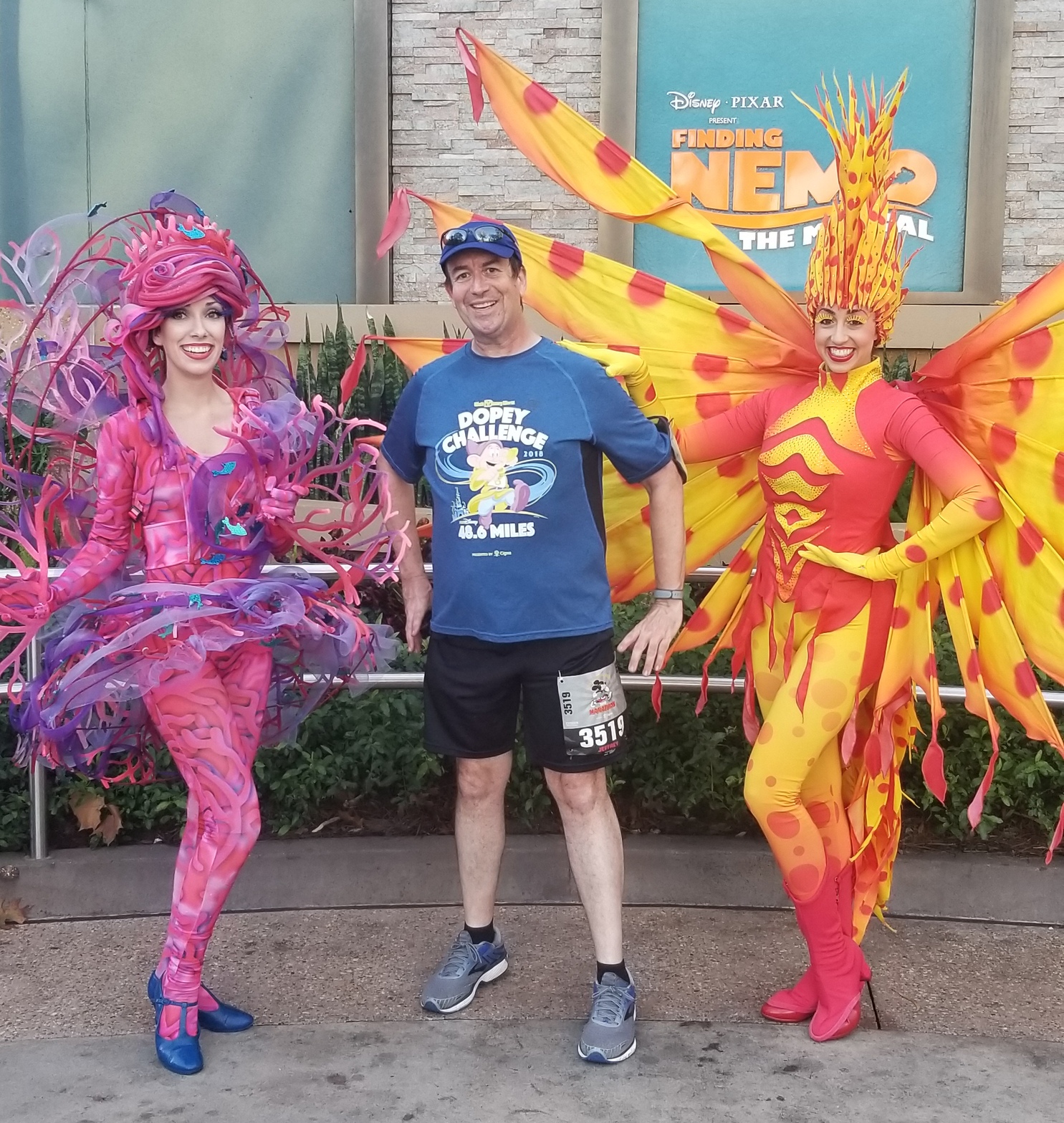I’ve run thirty seven marathons in the last twelve years. It would have been over forty by now if the pandemic hadn’t cancel almost all of my races in the past two years, but I shall revive my marathon count by running the California International Marathon in December.
So what is it like to run a marathon?

Me displaying yet
another Marathon Medal!
Pre-race
The nightmare that marathon runners fear the most is the hotel alarm not going off and you end up missing the start of the big race, so I always bring an extra alarm clock as a backup. It’s also difficult to get any sleep the night before a marathon, and I’ve often gone off to run a marathon with a just a few hours of sleep.
I take a quick shower and have a light breakfast, usually light baked goods like croissants, along with a couple of bananas and maybe a sports bar. I don’t eat anything too heavy or too sweet, nothing that will weigh me down or cause GI problems during the run. No peanut butter! I learned the hard way that peanut butter is a bad idea before a long race, at least for me.
If you take one of the marathon shuttles to get to the start line, which usually means a school bus designed for little kids and not full grown adults, (Smushes your knees,) you usually arrive quite early. In that case you have a lot of standing around to do and end up staring at your smart phone, maybe chatting with other runners, or double checking your equipment. I learned that if you can get to the start on your own, showing up later rather than earlier is best so you don’t have to wait so long before things get started.
The Start
After all the waiting and standing around, you go into your corral surrounded by a horde of runners who are just as antsy as you are. The race announcer is usually shouting exultations such as “Are you rrrrrrrrrrrrrrrrrready!” and the loud speakers are pumping out frantic dance music. If you’re not careful, all of the pre-start excitement and adrenaline means you can start running too fast and too hard when the horn blows, charging down the roadway and wearing yourself out too quickly for the rest of the run. It’s also a charge just being in the herd, being surrounded by all of those runners pounding the pavement. If you’re smart, which I sometimes am, you will start off the first few miles at an even and measured pace and avoid an early burnout.
An exception to the potential frantic rabbit start is if you’re running a really big race, as you’re caught in the middle of large packed-in crowd. It can be difficult to keep even a target pace just because of the traffic jam of runners at the beginning of a big race, and you can end up being forced to run under your target pace. I’m thinking of races like New York, Walt Disney, and the San Francisco marathons.

The crowd in my corral just before
the start of the 2016 Los Angeles Marathon
Miles Three through Six
This is where I adjust. If I got caught up in the start line hype and charged out too fast, I’ll slow down and try to run a steadier pace so I don’t tire myself out later on. If I didn’t get caught up and Jack rabbited the start, I will try and run a decent pace just slightly below my target pace so I can save my energy for later.
It’s around this time that you start getting into your stride, when you start to pick up a rhythm. If you’re not careful, you could start running too fast. Too many times I’ve hit a running stride and just started gazelling down the course. That’s why having a Garmin GPS watch or similar device that you can easily eyeball during your run is handy, so you can keep track of your pace.
Miles Six Through Ten
Now you’re adjusting your pace and doing calculations. This is where your runner’s math skills come into play. If you’re shooting for a personal best, you’re calculating your target pace compared with the current elapsed time, all while reminding yourself that you still have a long way to go. I’ve also learned through experience that downing those sports drinks that they hand out at the water stations are essential around this time, at least for me. You may not feel like drinking electrolytes just yet, but getting your fuel in early is something I wish someone had told me before I ran my first marathon back in 2009. Those sickly sweet drinks and gel shots will make a big difference later on in the race.
Miles Ten through 13.1
Mile ten is one of the benchmarks, meaning that you have completed more than one third of the course! (And double digits!) This is time for serious evaluation. Are you running too fast? Are you going too slow? If this is a “just finish” marathon I want to keep a steady pace, but if it’s a PR attempt this is where I would probably switch gears to try and run a bit faster to keep up my target pace, epsecially if I’m lagging.
Hitting the halfway mark is also exciting. If there were any physical problems that might derail your marathon, such as a strained calf or a gamey foot that would force a DNF, (Did not finish,) they would have most likely happened by now. It’s also the mental idea of “All downhill from here,” meaning you’ve finished half of the course and now it becomes a countdown.

Halfway done at my last California
International Marathon back in 2018!
Miles fourteen through nineteen
Now you’re counting down the miles, checking your pace, and mentally calculating your finish time. “Lessee, I have ten miles to go and at this pace with the time that’s already passed right now I should finish with a time of…” Yadda yadda yadda.
I mentioned that any potential physical problems that could knock you out of the race have already passed by. But there can still be things slowing you down: some annoying foot pain, a tight muscle somewhere in your leg that’s just bugging you, or an aching knee. This is where you try to power through an annoyance that might be slowing you down, or might even be threatening you with a late race DNF.
This is also the stretch where fatigue can start to really settle in. This is where the sports drinks and the cheering crowd can really make a difference. Yes, all of those cheering and high fiving people with their silly signs and cowbells and horns and jumping up and down really do make a big difference, especially for slower marathon runners like myself, as well as the people struggling with energy or physical issues. Marathon spectators should know that it’s the runners who come later on in the race that really need that support, the turtles like me who show up after the gazelles have already passed.
Mile Twenty and The Wall
Before I ran my first marathon a few marathon friends told me that for my first marathon the first twenty miles were going to be physical and the last six were going to be mental. And they weren’t kidding. At my first marathon, San Francisco in 2009, I completely hit the wall, as they say, at mile twenty. I was physically done. No energy left at all. The last six point two miles were grueling. It was all a matter of sheer willpower after that twenty mile mark.
Nowadays I will hit the wall occasionally during a marathon, but not as often or as hard as I used to in my earlier days of marathoning. During an Oakland Marathon I hit the wall so hard I thought I was going to have to drop out of the race, but I mustered up my gumption and finished the race.
For other marathons I kept on cruising, not losing too much in the way of energy and drive, even after the twenty mile mark. When you run enough marathons, mile twenty could be a run through, or hitting the wall, or something in between.
But regardless of where you’re at, mile twenty is the tipping point. This is where you tell yourself, “It’s just a 10K now,” because 10Ks are easy when you’re used to running marathons, so if you think of it that way it’s easier to tackle the last part. Because this is where your mental toughness and your state of mind really come into play, more so than at any other point in the marathon.
Miles Twenty one through twenty Six
The final countdown! This is where you push yourself. Unless you’re super fatigued or running through an injury that’s slowing you down, you try and give yourself a push for the final six. This is where you’ve had so many sports drink and gel shots that they are starting to taste awful, but you keep downing them anyway, because now is when you really need them.

Fan support really does have a huge impact on performance,
especially later on in the race!
This is also the part where the weather can really have a huge impact. During one Portland Marathon it was so hot that people on the residential part of the course had put sprinklers in the middle of the street for us to run through. The heat was slowing everyone down, especially later in the race. During one California International Marathon is was so cold that water at ice stations instantly froze when it hit the ground, (We slid through some of those water stations,) and the cold really slowed me down in the last six miles, which is unusual for me. I usually run faster and better in colder weather. Not in near-arctic conditions, however, as I found out.
Regardless, it’s the final countdown of the marathon. At mile twenty three I tell myself “Only a 5K now!”
And really, after hitting the twenty mile mark fatigue and physical discomfort are basically irrelevant. By then you’ve just run twenty miles. There’s simply no way you can quit now, no matter how wiped out and achey and sick of gels shots you are. How could you live with yourself if you didn’t finish the race at this point?
The last 0.2 Miles
A lot of people say “Isn’t a marathon twenty six miles?” A marathon is actually twenty six point two miles. And that last one fifth of a mile is when you usually see the finish line. When you do see that giant arch, or banner, or, if you’re at a smaller race, the finish line volunteers waving and cheering, every bit of stress, discomfort, and fatigue disappears, and you charge through.
That is the best part of the marathon, when you finally finish. You feel accomplished, you feel relieved that it’s finally over, but the most overwhelming feeling is that you are a tough as nails badass.
Because, if you run and complete a marathon, you totally are.
The Aftermath
After my first Chicago Marathon I was taking the subway back to my hotel, standing on the train, when a woman saw my marathon medal and offered me a seat, saying I should probably sit down if I had just ran a marathon. I told her thanks for the offer, but if I sat down I would just have to stand up again.
I’ve felt fine after some marathons, but for many of them, right after you finish, your body starts to settle since it isn’t moving anymore. That’s when your muscles tighten up and your thighs start to ache, and maybe that tight muscle or random pain that was only kind of bugging you really starts to flare up. At the finish line area of a marathon you will see a lot of runners walking slowly and gingerly or limping around.
Right after a marathon I’m more thirsty than hungry. You would think one would be completely famished after running that much, but my overriding desire is for liquids: Milk, water, soda, just something to quench my thirst. I’ve gone out after a marathon and just drank a lot of different drinks rather than chow down a big meal.
Eventually, once I’ve settled down from a marathon run, I’m in the mood for a decent meal, usually something kind of filling and with a decent amount of carbs. (Pizza!)
The day after can be difficult. Stairs are not your friend. Some people may see me getting out of a car slowly, or lumbering down the street like Frankenstein and think “That old guy can’t move around very well,” thinking I’m getting decrepit. It’s like, no, I just ran a distance that most people are too lazy to drive, much less run.
And that is what it’s like to run a marathon.

Me at the Walt Disney World Marathon, 2019!
Thirty Seven marathons is something amazing. Wonderful, mate. Keep Going👍
Wonderful read I would love to share on Powered by Pixie Dust
This was a fun read since I defiantly cannot run a marathon. Maybe one day. Thanks for sharing.
~Michelle
https://michellescrazybusylife.net
What a wonderful blog post Jeffrey. Congratulations on your several completions of marathons. Such wonderful accomplishments. I was so excited to have completed one 1/2 marathon several years ago. I enjoyed your blog
Pastor Natalie
Letstakeamoment.com
Really insightful post… I juat started to train to run… bit my milestone is still smaal just to do a 3k run in 2022… great post
Absolutely incredible — what an amazing achievement! Thanks for sharing a bit about what it’s like.